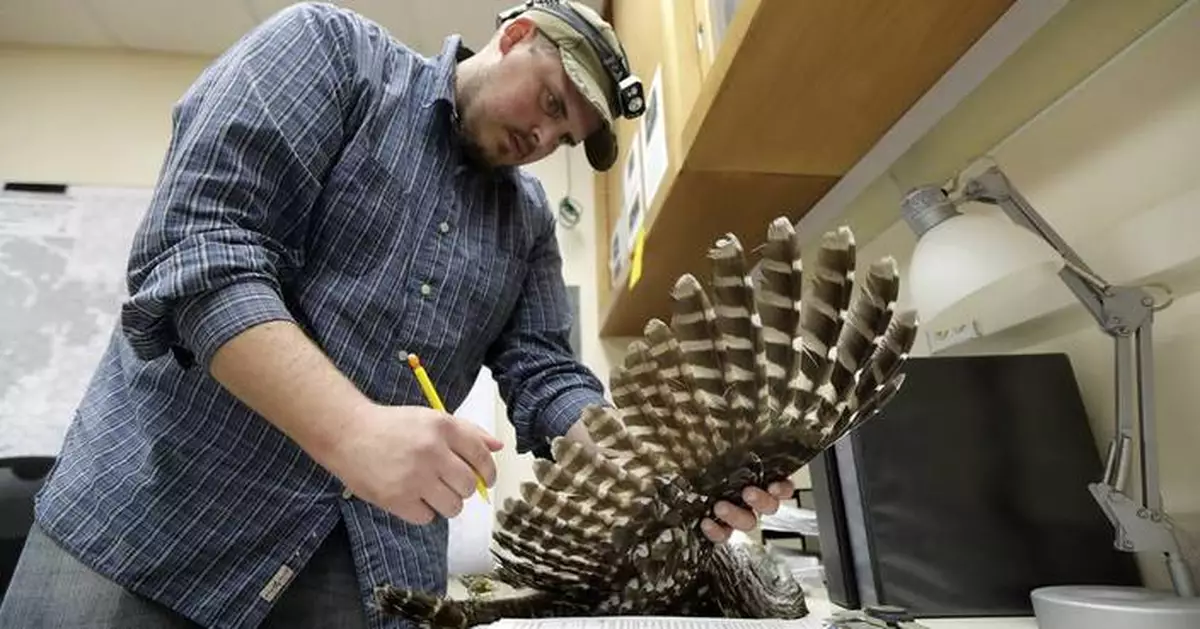To save the imperiled spotted owl from potential extinction, U.S. wildlife officials are embracing a contentious plan to deploy trained shooters into dense West Coast forests to kill almost a half-million barred owls that are crowding out their cousins.
The U.S. Fish and Wildlife Service strategy released Wednesday is meant to prop up declining spotted owl populations in Oregon, Washington state and California. The Associated Press obtained details in advance.
Documents released by the agency show up to about 450,000 barred owls would be shot over three decades after the birds from the eastern U.S. encroached into the West Coast territory of two owls: northern spotted owls and California spotted owls. The smaller spotted owls have been unable to compete with the invaders, which have large broods and need less room to survive than spotted owls.
Past efforts to save spotted owls focused on protecting the forests where they live, sparking bitter fights over logging but also helping slow the birds' decline. The proliferation of barred owls in recent years is undermining that earlier work, officials said.
“Without actively managing barred owls, northern spotted owls will likely go extinct in all or the majority of their range, despite decades of collaborative conservation efforts," said Fish and Wildlife Service Oregon state supervisor Kessina Lee.
The notion of killing one bird species to save another has divided wildlife advocates and conservationists. It's reminiscent of past government efforts to save West Coast salmon by killing sea lions and cormorants that prey on the fish, and to preserve warblers by killing cowbirds that lay eggs in warbler nests.
Some advocates grudgingly accepted the barred owl removal strategy; others said it's reckless diversion from needed forest preservation.
“The Fish and Wildlife Service is turning from protector of wildlife to persecutor of wildlife,” said Wayne Pacelle, founder of the advocacy group Animal Wellness Action. He predicted the program would fail because the agency won't be able to keep more barred owls from migrating into areas where others have been killed.
The shootings would likely begin next spring, officials said. Barred owls would be lured using megaphones to broadcast recorded owl calls, then shot with shotguns. Carcasses would be buried on site.
The birds already are being killed by researchers in some spotted owl habitats, with about 4,500 removed since 2009, said Robin Bown, barred owl strategy leader for the Fish and Wildlife Service. Those targeted included barred owls in California’s Sierra Nevada region, where the animals have only recently arrived and officials want to stop populations from taking hold.
In other areas where barred owls are more established, officials aim to reduce their numbers but acknowledge shooting owls is unlikely to eliminate them entirely.
Supporters include the American Bird Conservancy and other conservation groups.
Barred owls don’t belong in the West, said American Bird Conservancy Vice President Steve Holmer. Killing them is unfortunate, he added, but reducing their numbers could allow them to live alongside spotted owls over the long term.
“As the old forests are allowed to regrow, hopefully coexistence is possible and maybe we don’t need to do as much” shooting, Holmer said.
The killings would reduce North American barred owl numbers by less than 1% annually, officials said. That compares with potential extinction for spotted owls, should the problem go unaddressed.
Because barred owls are aggressive hunters, removing them also could help other West Coast species that they've been preying on such as salamanders and crayfish, said Tom Wheeler, director of the Environmental Protection Information Center, a California-based conservation group.
Public hunting of barred owls wouldn't be allowed. The wildlife service would designate government agencies, landowners, American Indian tribes or companies to carry out the killings. Shooters would have to provide documentation of training or experience in owl identification and firearm skills.
The publishing in the coming days of a final environmental study on the proposal will open a 30-day comment period before a final decision is made.
The barred owl plan follows decades of conflict between conservationists and timber companies, which cut down vast areas of older forests where spotted owls reside.
Early efforts to save the birds culminated in logging bans in the 1990s that roiled the timber industry and its political supporters in Congress.
Yet spotted owl populations continued declining after barred owls started showing up on the West Coast several decades ago. Across the region at least half of spotted owls have been lost, with declines of 75% or more in some study areas, said Katherine Fitzgerald, who leads the wildlife service's northern spotted owl recovery program.
Opponents say the mass killing of barred owls would cause severe disruption to forest ecosystems and could lead to other species — including spotted owls — being mistakenly shot. They’ve also challenged the notion that barred owls don’t belong on the West Coast, characterizing their expanding range as a natural ecological phenomenon.
Researchers say barred owls moved westward by one of two routes: across the Great Plains, where trees planted by settlers gave them a foothold in new areas; or via Canada’s boreal forests, which have become more hospitable as temperatures rise because of climate change.
Northern spotted owls are federally protected as a threatened species. Federal officials determined in 2020 that their continued decline merited an upgrade to the more critical designation of “endangered.” But the Fish and Wildlife Service refused to do so at the time, saying other species took priority.
California spotted owls were proposed for federal protections last year. A decision is pending.
Under former President Donald Trump, government officials stripped habitat protections for spotted owls at the behest of the timber industry. Those were reinstated under President Joe Biden after the Interior Department said political appointees under Trump relied on faulty science to justify their weakening of protections.
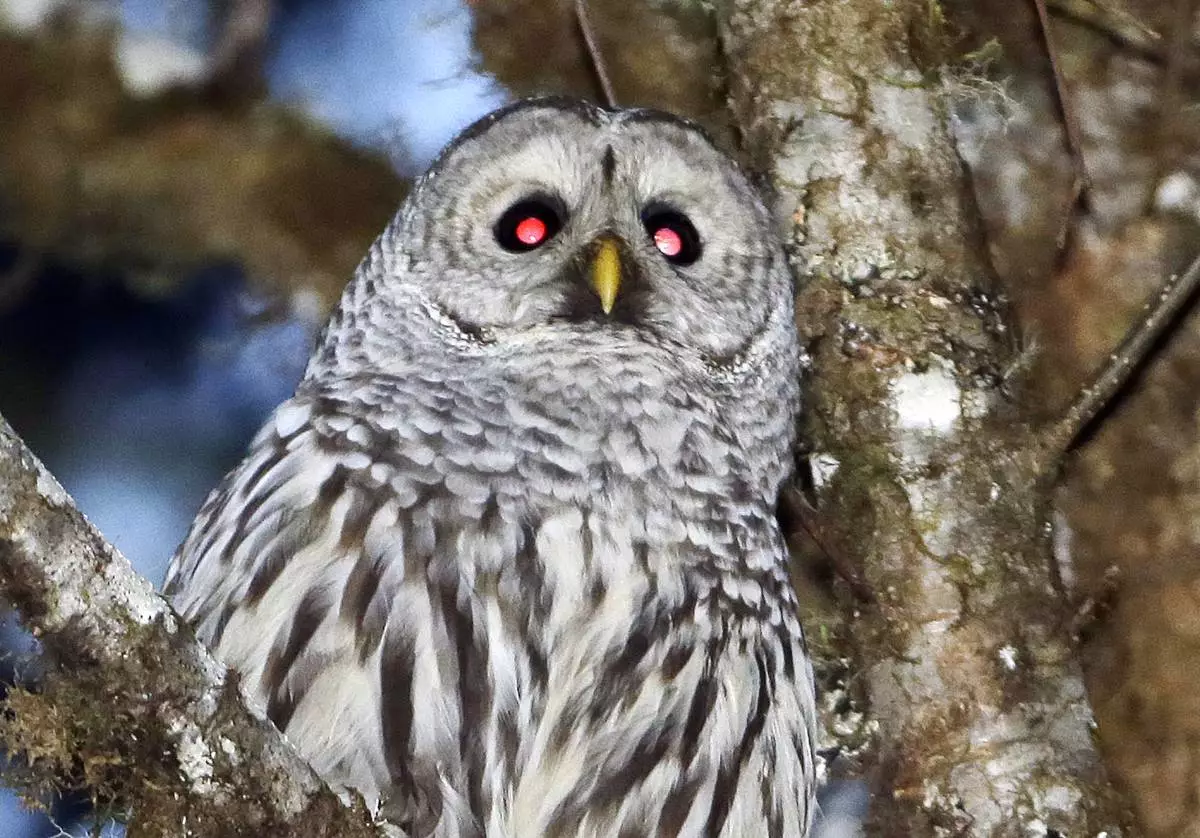
FILE - A barred owl is shown in the woods outside Philomath, Ore., Dec. 13, 2017. To save the imperiled spotted owl from potential extinction, U.S. wildlife officials are embracing a contentious plan to deploy trained shooters into dense West Coast forests to kill almost a half-million barred owls that are crowding out their smaller cousins. (AP Photo/Don Ryan, File)

FILE - A female barred owl sits on a branch in the wooded hills, Dec. 13, 2017, outside Philomath, Ore. To save the imperiled spotted owl from potential extinction, U.S. wildlife officials are embracing a contentious plan to deploy trained shooters into dense West Coast forests to kill almost a half-million barred owls that are crowding out their smaller cousins. (AP Photo/Don Ryan, File)
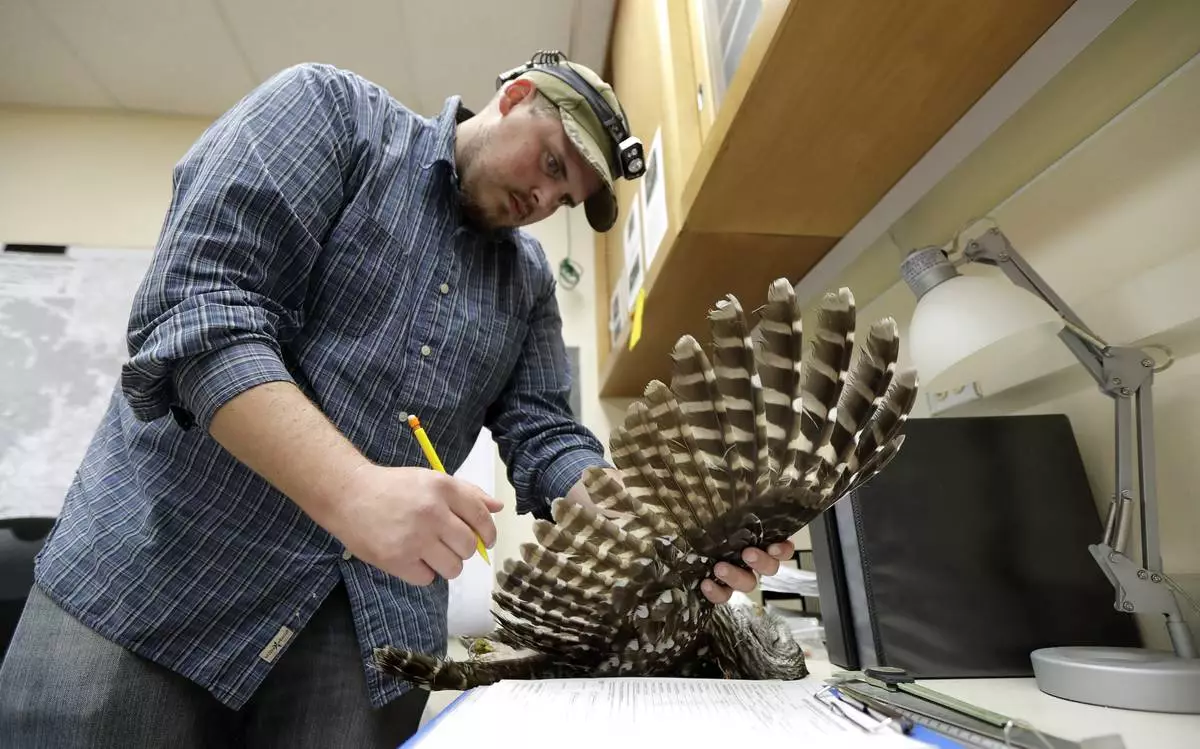
FILE - Wildlife technician Jordan Hazan records data in a lab from a male barred owl he shot earlier in the night, Oct. 24, 2018, in Corvallis, Ore. U.S. wildlife officials want to kill hundreds of thousands of barred owls in coming decades as part of a controversial plan to help spotted owl populations. (AP Photo/Ted S. Warren, File)
PORTLAND, Ore. (AP) — A slow-moving and potentially record-setting heat wave is spreading across the Western U.S., the National Weather Service said, sending many residents in search of a cool haven from the dangerously high temperatures. The Southeast and Mid-Atlantic regions of the U.S. are also sweltering, with oppressive heat and humidity expected to last through Saturday.
Widespread temperature records are expected to be tied or even broken during the heat wave, with much of the West Coast likely to see triple-digit temperatures that are between 15 and 30 degrees Fahrenheit (8 and 16 degrees Celsius) higher than average, the National Weather Service said.
“The duration of this heat is also concerning as scorching above average temperatures are forecast to linger into next week,” the weather service said.
In the Portland, Oregon, suburb of Gresham, Sherri Thompson, 52, was waiting in her car with her 14-year-old chihuahua Kiwani for a cooling center to open late Friday morning. Thompson has lived in her car for three years and can only run its air conditioning for about 20 minutes at a time as it causes the engine to overheat.
Thompson said the high temperatures prompted health concerns, as she had been hospitalized for a heat stroke in the past.
“I have anxiety and panic attacks and I get worried. I don’t want to have another heat stroke, and everything just triggers my anxiety a lot,” she said.
Inside the air conditioned center, Multnomah County spokesperson Julia Comnes oversaw county staff and people working with a local homeless services provider as they lined up thin mattresses in rows on the floor and set up cots for people with disabilities. She said the space had capacity for up to 80 people.
“Some of the hazards associated with this weekend especially is that it’s still pretty early in the season. We had a pretty cool June, so our bodies aren’t totally acclimated yet to the heat,” she said. “For people living outside or more vulnerable people, the cooling space like this is really important for them to just cool off for a few hours.”
The blistering weather in the Portland region is expected to last at least through Monday, National Weather Service meteorologist Clinton Rockey said. If the triple-digit temperatures (well over 37 degrees Celsius) stretch into Tuesday, then the region will match a record last seen in July 1941, with five consecutive days of more than 100-degree weather, Rockey said. The temperatures aren't expected to peak as high as they did during a similar heat wave in 2021 — which killed an estimated 600 people across Oregon, Washington and western Canada — but the duration could pose a problem, Rockey said.
Many homes in the region lack air conditioning, and round-the-clock hot weather means people’s bodies aren’t able to sufficiently cool down at night. The issue is compounded in many city settings, where concrete and pavement can store the heat, essentially acting as an oven.
“That's what drives people batty,” Rockey said. “It's going to be obnoxious. And unfortunately for some people, if you're not having good shelter, it could be a very challenging, life-threatening situation.”
In Arizona’s Maricopa County, which encompasses Phoenix, there have been at least 13 confirmed heat-related deaths this year, while the causes of more than 160 other suspected heat deaths were still under investigation, according to the county’s most recent report on such deaths through June 29.
That doesn’t include the death of a 10-year-old boy earlier this week in Phoenix, who suffered a “heat-related medical event” while hiking with his family at South Mountain Park and Preserve, according to the Phoenix Police Department.
Among extremes, the forecast for Furnace Creek in Death Valley National Park calls for daytime highs of 129 degrees (53.8 degrees Celsius) on Sunday, and then around 130 (54.44 C) through Wednesday. The official world record for hottest temperature recorded on Earth was 134 degrees (56.67 C) in Death Valley in July 1913, but some experts dispute that measurement and say the real record was 130 recorded there in July 2021.
At Bullhead City, Arizona, the temperature already had reached 111 degrees (44.4 C) by 11 a.m. Friday. The city opened a pair of cooling centers for seniors and others, but locals seemed to be taking it in stride.
“While this is a heat wave and we urge everyone to be cautious, we typically don’t see large attendance at our cooling centers unless there are power outages,” Bullhead City spokesperson Mackenzie Covert said Friday. “Our community is hot every summer. Our residents are kind of aware of it. They all tend to have working air conditioners.”
Figure skaters took to the ice at the Reno Ice Rink in Nevada starting at 6 a.m. Friday, general manager Kevin Sunde said. By the time the rink closes at 10:30 p.m. on Friday, Sunde expected nearly 300 people would have visited, with more parents hanging around to watch kids' hockey practice than usual.
“They may not be getting on the ice themselves, but enjoying the cool,” Sunde said. “We’re the only sheet of ice within about an hour’s drive.”
In Norfolk, Virginia, Kristin Weisenborn set up her table at an outdoor farmer's market to sell sourdough bread. The air was hovering just below the triple digits, but the 58% humidity in the air made it feel more like 114 degrees (46 C), according to the National Weather Service.
“It’s so hot, I just hope there’s a lot of people here that can buy my bread,” said Weisenborn, 42, whose Krid’s Crumbs bakery is based in Virginia Beach.
“Otherwise we’re just standing here sweating,” she said, adding that unsold bread will be donated or frozen.
Despite the layer of unmoving humidity that hung between tables, people were already buying Weisenborn’s loaves of bread as the market got underway.
“It’s hot, but it’s July,” Weisenborn added. “Better than snow, I guess.”
Boone reported from Boise, Idaho. Associated Press journalists Scott Sonner in Sparks, Nevada; Jonathan Drew in Raleigh, North Carolina; John Antczak in Los Angeles; Rio Yamat in Las Vegas; Denise Lavoie in Richmond, Virginia; and Ben Finely in Norfolk, Virginia contributed.

Radha Ramya, second from right, eats her ice cream with family members Nadamuni Ramya, from left, Dinakar Ramya, Nirvi Ramya and Devineni Ramya at the National Mall near the U.S. Capitol, Friday, July 5, 2024, in Washington. (AP Photo/Mariam Zuhaib)
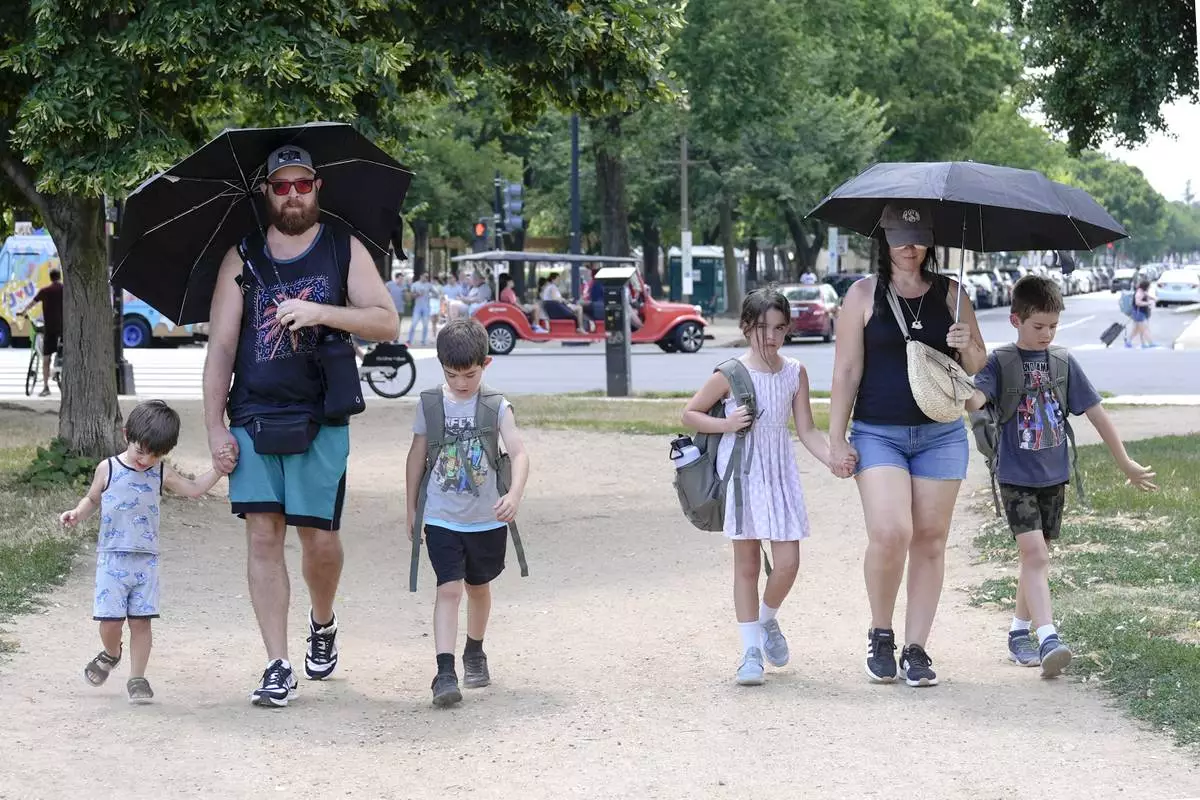
Jordan Savant, second from left, walks with his family carrying umbrellas on the National Mall near the U.S. Capitol, Friday, July 5, 2024, in Washington. (AP Photo/Mariam Zuhaib)

Wesam Horni, center, sells water on the National Mall near the U.S. Capitol, Friday, July 5, 2024, in Washington. (AP Photo/Mariam Zuhaib)
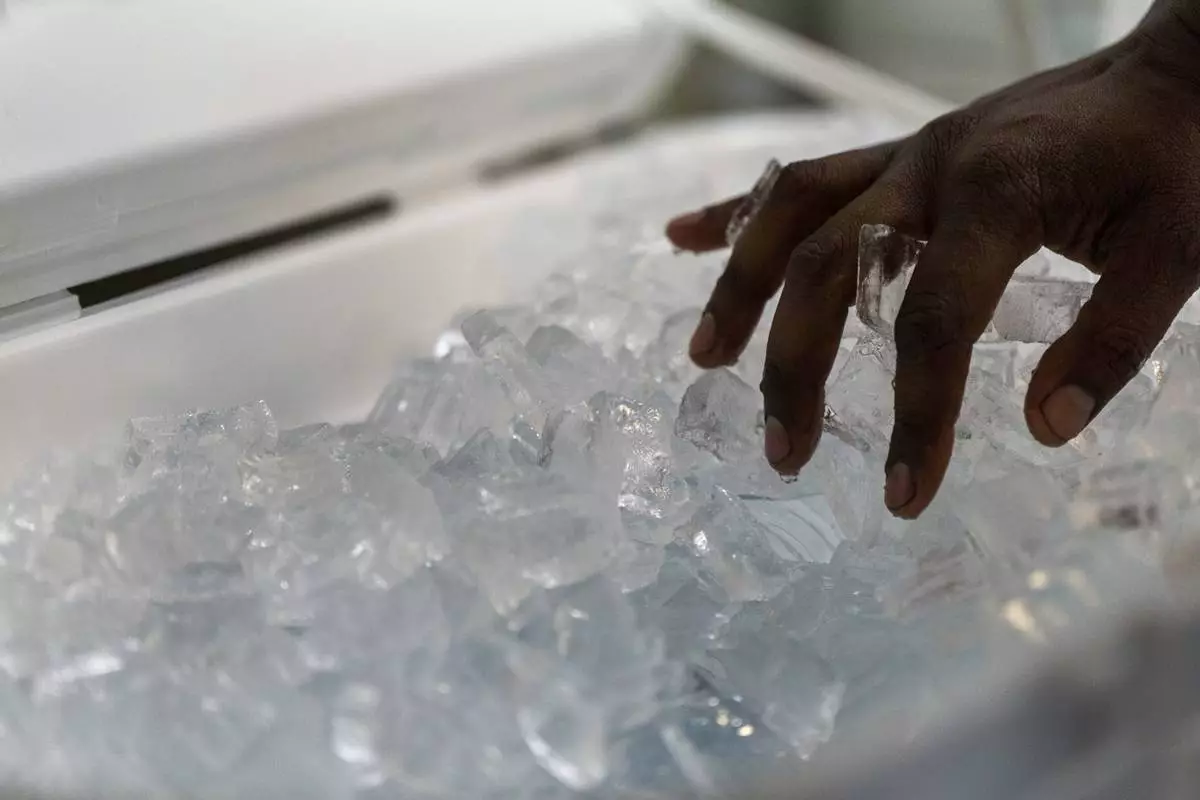
Ty Brown, with Cultivate Initiatives, puts ice over bottles of water as workers set up the Cook Plaza cooling center on Friday, July 5, 2024, in Gresham, Ore. A heat wave is spreading across Wester U.S., the national Weather Service said, sending many residents in search of a cool haven from the dangerously high temperatures. (AP Photo/Jenny Kane)
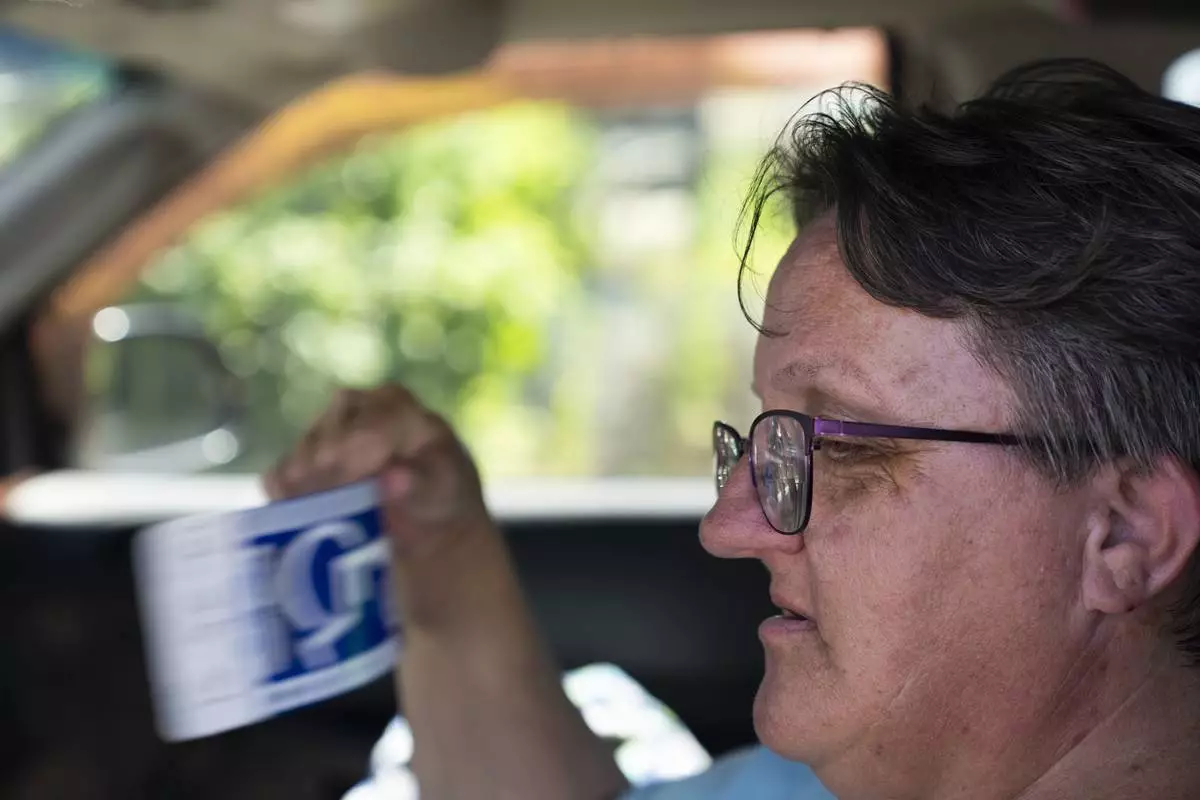
Sherri Thompson uses her disability parking sign to fan off as she waits for the Cook Plaza cooling center to open on Friday, July 5, 2024, in Gresham, Ore. Thompson has lived in her car for three years, and can only run its air conditioning for about 20 minutes at a time as it causes the engine to overheat. A heat wave is spreading across Wester U.S., the national Weather Service said, sending many residents in search of a cool haven from the dangerously high temperatures. (AP Photo/Jenny Kane)
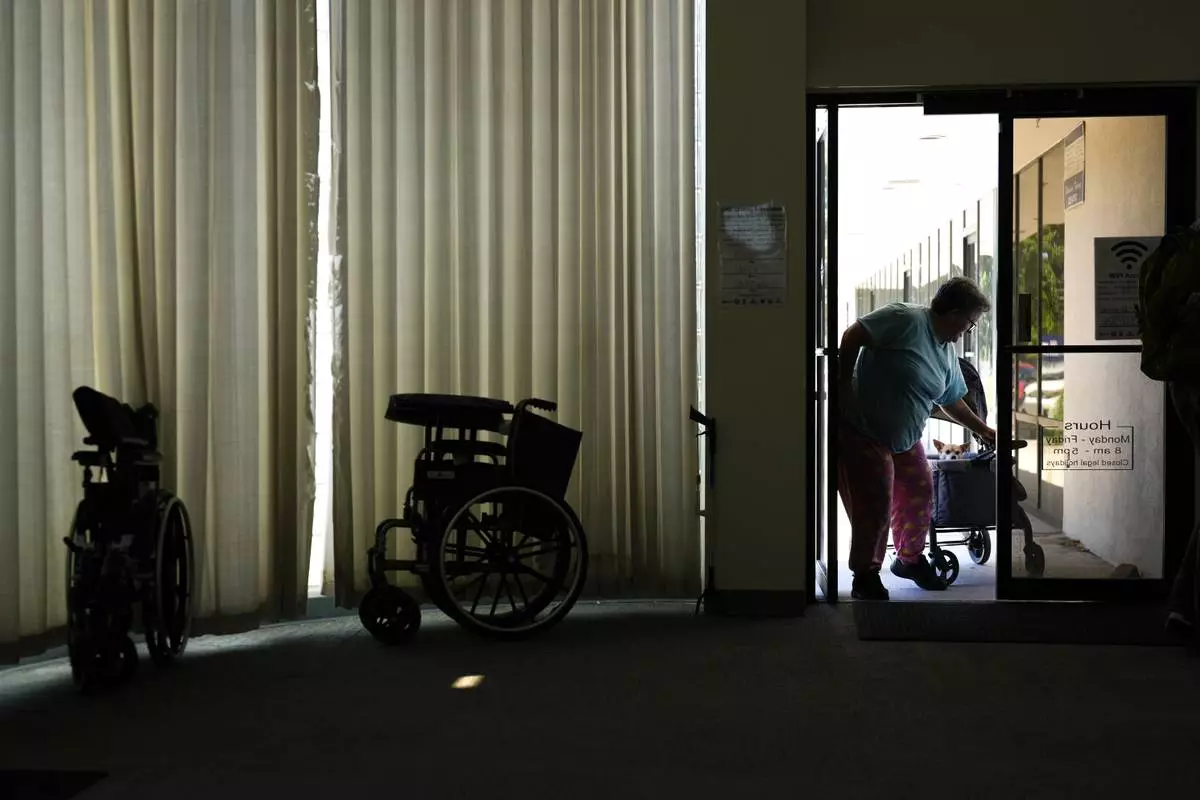
Sherri Thompson, with her chihuahua 14-year-old Kiwahi, arrives at the Cook Plaza cooling center on Friday, July 5, 2024, in Gresham, Ore. Thompson has lived in her car for three years, and can only run its air conditioning for about 20 minutes at a time as it causes the engine to overheat. Thompson said the high temperatures prompted health concerns, as she had been hospitalized for a heat stroke in the past. A heat wave is spreading across Wester U.S., the national Weather Service said, sending many residents in search of a cool haven from the dangerously high temperatures. (AP Photo/Jenny Kane)
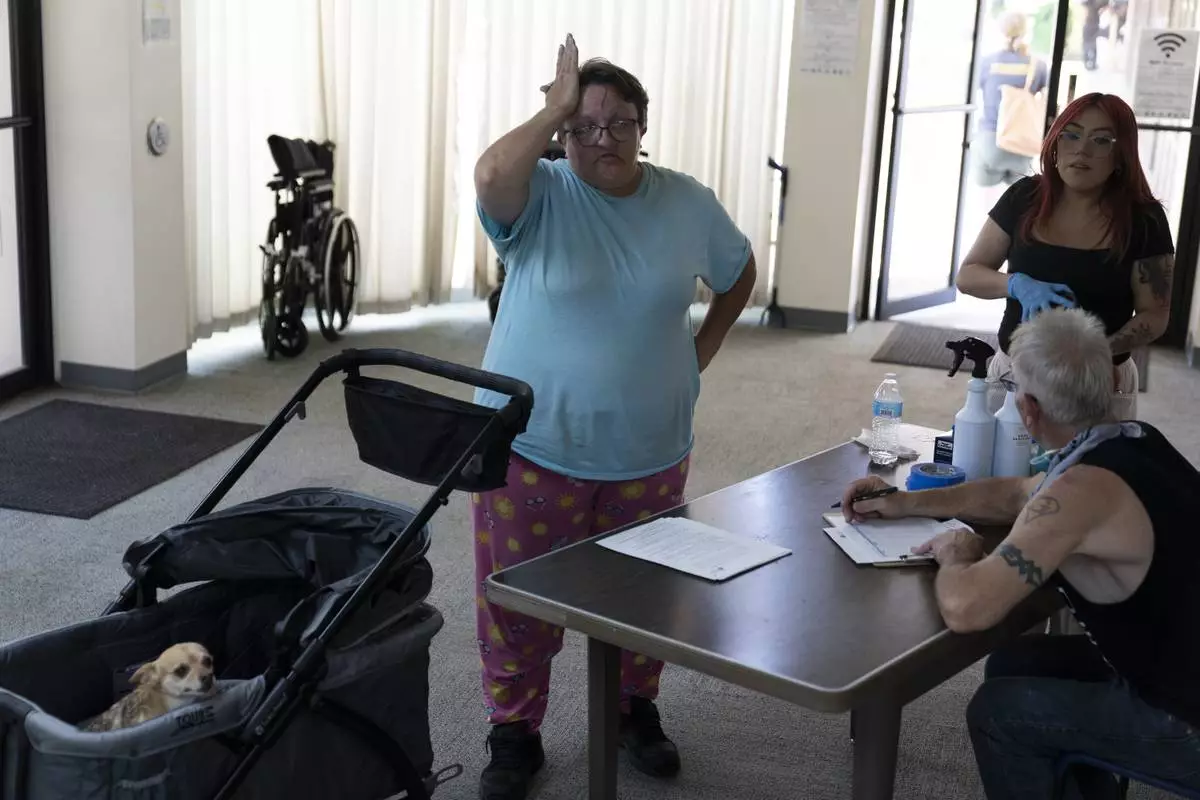
Sherri Thompson, with her chihuahua 14-year-old Kiwahi, arrives at the Cook Plaza cooling center after waiting for the center to open on Friday, July 5, 2024, in Gresham, Ore. Thompson has lived in her car for three years, and can only run its air conditioning for about 20 minutes at a time as it causes the engine to overheat. A heat wave is spreading across Wester U.S., the national Weather Service said, sending many residents in search of a cool haven from the dangerously high temperatures. (AP Photo/Jenny Kane)

Sherri Thompson, with her chihuahua 14-year-old Kiwahi, waits in her vehicle for the Cook Plaza cooling center to open on Friday, July 5, 2024, in Gresham, Ore. Thompson has lived in her car for three years, and can only run its air conditioning for about 20 minutes at a time as it causes the engine to overheat. A heat wave is spreading across Wester U.S., the national Weather Service said, sending many residents in search of a cool haven from the dangerously high temperatures. (AP Photo/Jenny Kane)
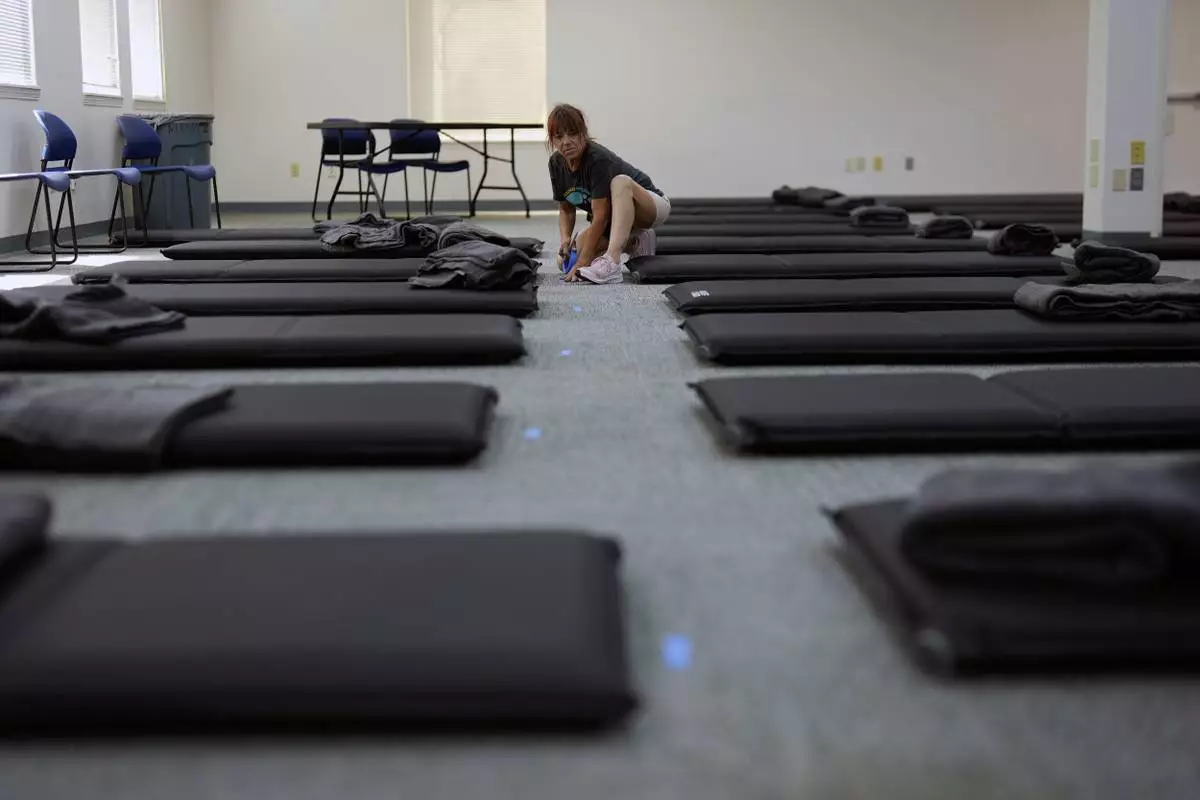
Doll Crain, with Cultivate Initiatives, marks off places for beds as workers set up the Cook Plaza cooling center on Friday, July 5, 2024, in Gresham, Ore. A heat wave is spreading across Wester U.S., the national Weather Service said, sending many residents in search of a cool haven from the dangerously high temperatures. (AP Photo/Jenny Kane)





